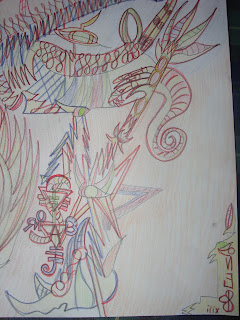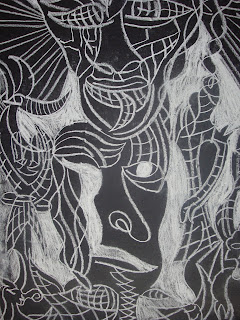Analysis of a
Blake aphorism
A quote by William Blake, from his Book of Job, has been
both puzzling and inspiring me for some time now. I originally saw it written,
rather clandestinely on the back of the Psychonaut 12”ep by “Fields of the
Nephilim.” Therefore I have done a little research regarding, and also
meditation on this intriguing and valiantly esoteric aphorism. The quote reads:
“Of Behemoth, he saieth, he is chief of the ways of God. Of
Leviathan, he saieth, he is King over all the Children of the Pride.”
My first thought ,when confronting this aphorism was the
concept of a parting of the ways,which occured when these great daemon Behemoth
and Leviathan fought each other and an extraneous force enabled this battle,
call it godhead or the absolute or as you wish. I call it Chaos and use this
metaphor as an epitaph of creation.
One must first consider Blake’s interpretation of the book
of Job contained in the Bible, from which this quote stems and the relevance of
this aphorism in the time it was written. According to the Tate website, this
quote refers to the use of the apocalyptic daemon of the bible, “Behemoth”and
“Leviathan.” Blake uses this battle in his book “Jerusalem”as an analogy to
represent War by Land and Sea. This
explicit link is seen by Blake's inclusion of two pictures in the book ,of
Admiral Nelson and the then prime minister William Pitt. One interpretation of
this design may be that these beasts stand for the “hopelessness of material
nature.”And in reference to the book of Job, God is pointing out the
negativeness of Job’s faith so far, as he is continually tested by his creator,
after a severe run of bad luck.
As this quote has been used on the “Fields of the Nephilim”
“Psychonaut 12,” it is possible that this
usage was taken to infer a transcendence of consciousness delegated by
the chaosphere of chance and change. The
very name Psychonaut is given to an entity who deals with magical matters on
different planes of consciousness. A magician or sorcerer if you like, it is
also possible that not unlike Blake, the
group and it’s focal point, vocalist Carl McCoy is drawing attention to the
sterility of modern life and those who call themselves warriors, but are
actually war-starters and have lost their humanity, humility and magical
potency.
In reference to the group’s name, the Nephilim were the
offspring between the union of mortal women and the fallen watcher angels who
subsequently taught the world of men everything they knew. The fields are
magnetic, drawing us towards a convocation with the Watchers who are said to
burn with a smokeless fire. It is philosophically speaking a metaphor for
humanity uniting with their higher Enochian self.
It is arguably possible therefore that this union is a part
of Man’s intrinsic magical need to bear witness to a chaotic (re) union with
creation and godhead. This is symbolized by the two Biblical Daemon, Behemoth
and Leviathon.Is it not possible then that the communion with the Watchers could be the
dinosaurs by which these great chao-forces manifest themselves.
I also wished to take Blakes aphorism further back than
biblical times perhaps 2-3000 years before the birth of Christ into Ancient
Mesopotamia and the time of Sumer and Babalon.
In Jewish mysticism Leviathon is seen as being intrinsically
feminine, so in my thinking this correlates to the Sumerian lunar Serpent Goddess
Tiamat who was divided into pieces by the sword of the solar hero Marduk. In
Orryelle Defenstrate-Bascule’s Tela-Quadrivium,Tela is latin for weaving and as
the quadrivium is A bookweb this is most profound.The author states that in
Sumerian Mythology Tiamat was “cleft into the Earth and the sky…thus began
linear time as we know it. So too if you divide Tiamat’s very name you have the
segments of such ordered time-keeping as the Babylonians introduced our (12/60)
system.”(Orryelle Defenstrate-Bascule,Solve,Fulgur,2012)
Perhaps in Blakes quote Behemoth and Leviathon fulfil these
places and correlate to the Sumerian Creation story. In the author and enchanter Lovecraft’s weird tales Tiamat is
known as Cthulu one of the ancient ones who cannot be summoned but who is
continually attempting to reify itself in the depths of our unconscious mind. Marduk
therefore is seen as an Elder God and the saviour of both creation and mankind.
It is my belief that Lovecraft was somewhat Catholic and neurotic in his views
and so made Cthulu male, this correlates to the monotheistic fear of the lunar and the intrinsic feminine
principle that pervades all post-modern occultism and which although contrary
to Crowley’s male,solar doctrine, is the truth along with sex that underlies
all considered magical practice.
In conclusion I would like to say that Blake was clearly a
very spiritual person, almost gnostic in his approach, as to how religious and
monotheistic I do not know? Blake certainly used the Bible as stimulus for much
of his work. It is only from our standpoint of this assumed position at this
side of the light of time that we can take a step back and be truly objective
about how such a quote relates to currents of esoteric and occult practice “as
now”.

























